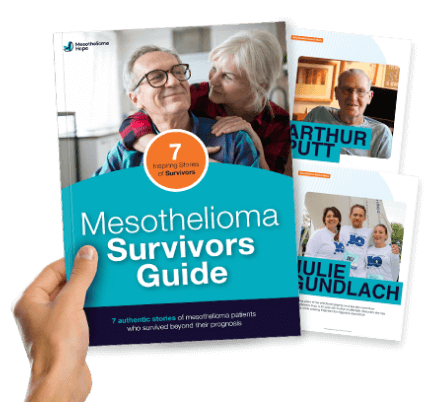What Is the Survival Rate of Mesothelioma?
Survival rate is the percentage of mesothelioma patients still alive for months or years after diagnosis. This rate is part of a patient’s mesothelioma prognosis their projected health outcome following diagnosis.
That said, survival rates can vary greatly depending on your mesothelioma type, the cancer treatments you receive, and many other factors.
Is Mesothelioma Survival Rate the Same Thing as Life Expectancy?

No. Mesothelioma life expectancy is the estimated time a patient is projected to live. It’s typically measured in years or months. The average mesothelioma life expectancy is 12-21 months.
Survival rate refers to the percentage of patients who live past a set amount of time following their diagnosis. It’s also a different metric from the mesothelioma mortality rate, which is the number of patients who have died after a set period of time.
How Long Can You Live With Mesothelioma?
The chart below shows mesothelioma survival rates at 1, 3, and 5 years.
| Time After Mesothelioma Diagnosis | Survival Rate |
|---|---|
| 1 year | 43.7% |
| 3 years | 16.8% |
| 5 years | 12% |
Since long-term mesothelioma survival rates are often poor, it can be scary to think about them. However, a survival rate is just an average, and you may be able to become a survivor with proper treatment.
Learn about mesothelioma patients who have gone on to live for 15+ years after being diagnosed in our Free Survivors Guide.
Factors That Affect Mesothelioma Survival Rates
Several factors affect your survival rate. These include your age, the type of cancer, when you’re diagnosed, and how aggressive the cancer cells are.
Learn more about factors impacting mesothelioma cancer survival rates below.
Survival Rates for Each Type of Mesothelioma
What type of mesothelioma someone has can greatly affect how long they live. Some types of mesothelioma are easier to treat than others. Thus, survival rates differ by each type.
Pleural Mesothelioma Survival Rate
Malignant pleural mesothelioma, which develops in the lining of the lungs (pleura), is the most common type of mesothelioma. However, its long-term survival rates are lower when compared to some of the other types of this cancer.
The chart below shows key pleural mesothelioma survival data.
| Time After Diagnosis | Survival Rate |
|---|---|
| 1 year | 73% |
| 3 years | 23% |
| 5 years | 12% |
| 10 years | 5% |
Pleural mesothelioma survival figures have been steadily increasing thanks to treatment breakthroughs, according to a 2022 report from Heidelberg University Hospital researchers.
Get access to top doctors who can help increase your survival time with our Free Mesothelioma Doctor Match.
Peritoneal Mesothelioma Survival Rate
Malignant peritoneal mesothelioma develops in the lining of the abdomen (peritoneum) and generally has the best prognosis compared to other types of mesothelioma.
View peritoneal mesothelioma cancer survival rates in the chart below.
| Time After Diagnosis | Survival Rate |
|---|---|
| 1 Year | 92% |
| 3 Year | 74% |
| 5 Year | 65% |
| 10 Year | 39% |
Peritoneal mesothelioma is much easier to treat than pleural mesothelioma, so these patients have better survival rates.
Pericardial Mesothelioma Survival Rate
Pericardial mesothelioma is a very rare form of this cancer. It forms in the heart’s lining and has arguably the worst survival rates of any type of mesothelioma.
| Time After Diagnosis | Survival Rate |
|---|---|
| 1 year | 26% |
| 3 years | 14% |
| 5 years | 9% |
Testicular Mesothelioma Survival Rate
Testicular mesothelioma develops in the lining of the testicles. It’s the rarest type of this cancer, but patients have relatively good long-term survival rates.
| Time After Diagnosis | Survival Rate |
|---|---|
| 5 Years | 49% |
| 10 Years | 33% |
Mesothelioma Survival Rates By Stage
Mesothelioma staging is one of the most useful ways to break down survival rate data. The stage of mesothelioma refers to how far the cancer has spread within the body by the time of diagnosis.
Pleural mesothelioma is the only type of this cancer with a staging system.
The following charts show pleural mesothelioma life expectancy and survival rates by stage when treated with surgery.
| Pleural Mesothelioma Stage 1 | |
|---|---|
| Life Expectancy | 19.2 months |
| 2-Year Survival Rate | 39% |
| 5-Year Survival Rate | 11% |
| Pleural Mesothelioma Stage 2 | |
|---|---|
| Life Expectancy | 19.2 months |
| 2-Year Survival Rate | 39% |
| 5-Year Survival Rate | 11% |
| Pleural Mesothelioma Stage 3 | |
|---|---|
| Life Expectancy | 18.9 months |
| 2-Year Survival Rate | 41% |
| 5-Year Survival Rate | 13% |
| Pleural Mesothelioma Stage 4 | |
|---|---|
| Life Expectancy | 13.1 months |
| 2-Year Survival Rate | 31% |
| 5-Year Survival Rate | 11% |
*Note: NCDB data indicates no difference in survival rates between Stage 1 and Stage 2.
If metastasis (when cancer spreads to other parts of the body) has occurred in the later stages, a patient’s overall survival rate will be lower as the cancer is harder to treat.
However, you may be able to improve your survival rate no matter the stage. Read stories of late-stage patients who became long-term survivors in our Free Survivors Guide.
Survival Rate by Mesothelioma Cell Type
Mesothelioma tumors can be made up of different types of cells. Because some of these cells respond better to treatment than others, cell type also impacts the survival rate.
Epithelioid is the most common and easiest to treat, so patients with epithelial mesothelioma often live longer than patients with other cell types. Sarcomatoid mesothelioma cells tend to spread rapidly through the body and do not respond well to treatment, so survival rates are poor.
| Epithelioid Mesothelioma Survival* | |
|---|---|
| 2-Year Survival Rate | 45% |
| 5-Year Survival Rate | 14% |
| Sarcomatoid Mesothelioma Survival* | |
|---|---|
| 2-Year Survival Rate | 15% |
| 5-Year Survival Rate | 4% |
*When treated with surgery
Biphasic mesothelioma tumors contain both epithelioid and sarcomatoid cells. Patients with biphasic mesothelioma may live longer if more epithelial cells are present.
| Biphasic Mesothelioma Survival* | |
|---|---|
| 2-Year Survival Rate | 22% |
| 5-Year Survival Rate | 5% |
*When treated with surgery
Mesothelioma Survival Rates By Patient Demographics
Most mesothelioma patients are men over the age of 65. However, anyone can develop mesothelioma, and some demographic factors can help or hinder survival.
The charts below show how sex, age, and race affect survival rates for mesothelioma.
Sex
Though mesothelioma mainly affects men, women with mesothelioma tend to live longer.
| Survival Rate | Male | Female |
|---|---|---|
| 1-Year Survival Rate | 41.3% | 51% |
| 2-Year Survival Rate | 21.3% | 33.8% |
| 3-Year Survival Rate | 13.6% | 26.5% |
| 4-Year Survival Rate | 10.1% | 21.9% |
| 5-Year Survival Rate | 8.0% | 18.8% |
Age
Older patients have a lower survival rate than younger mesothelioma patients.
Younger patients are typically in good overall health and respond better to treatment, such as aggressive surgeries that can help them live longer.
| Age Group | Overall Survival Rate |
|---|---|
| Under 50 | 44.7% |
| 50-64 | 21.2% |
| 65 and up | 8.3% |
| All ages | 13.5% |
Race
According to the Centers for Disease Control and Prevention (CDC), mesothelioma affects white people more than any other race. From 1999 to 2015, nearly 95% of all people who died in the U.S. due to mesothelioma were white.
White patients also have the lowest survival rates out of any race, as noted by the NCI.
| Race | 5-Year Survival Rate |
|---|---|
| Asian or Pacific Islander | 16% |
| Black | 17.6% |
| White | 12.8% |
Mesothelioma Survival Rates After Treatment
Patients may be able to live much longer and defy average survival rates with treatment from mesothelioma doctors.
Common mesothelioma treatment plans include surgery, chemotherapy, radiation, and other therapies.
Mesothelioma Survival Rate After Surgery
Mesothelioma surgery removes cancer tumors from the body. Different types of surgery can be used. Learn about mesothelioma surgery survival rates below.
- Cytoreduction with HIPEC: Used to fight peritoneal mesothelioma, this treatment combines heated chemotherapy and abdominal surgery. Patients who receive cytoreductive surgery with HIPEC have 5-year survival rates ranging from 36% to 53%, according to a 2022 review of various studies published by the Journal of Clinical Medicine.
- Extrapleural pneumonectomy (EPP): This surgery treats pleural mesothelioma and allows doctors to remove the lung closest to the cancer and as many cancer tumors as possible. When combined with radiation, patients who received an EPP had a 2-year survival rate of 21%, according to a 2020 study conducted by Mayo Clinic researchers.
- Pleurectomy with decortication (P/D): Also used to treat pleural mesothelioma, doctors remove the lung lining and all the cancer they can see but spare both lungs. As a result, patients typically recover with fewer side effects. The 5-year survival rate for epithelial mesothelioma patients who undergo this surgery is 29%, according to a 2021 Journal of Thoracic Disease study.
Mesothelioma Hope can help you find treatment at top cancer centers in your area. Use our Free Mesothelioma Doctor Match to get started.
Chemotherapy and Mesothelioma Survival Rate
Chemotherapy treatments are cancer-killing drugs that doctors administer. Chemotherapy can greatly improve survival rates of malignant mesothelioma when used alone or with other treatments.
Pleural mesothelioma patients had a 2-year survival rate of about 27% when treated with chemotherapy alone, according to a 2020 OncLive report.
Further, a 2022 report from the Journal of Clinical Haematology found that the 5-year survival rate of peritoneal mesothelioma patients was 80% if they were treated using cytoreduction with HIPEC and follow-up chemotherapy.
SMART: Surgery for Mesothelioma After Radiation Therapy
Some pleural mesothelioma patients receive a high dose of intensity-modulated radiation therapy (IMRT) followed by an EPP through the SMART approach.
Clinical studies have found that this procedure significantly improved survival rates compared to a surgery-first approach.
For example, epithelial pleural mesothelioma patients treated with SMART had a 42% 5-year survival rate, according to a Journal of Thoracic and Cardiovascular Surgery study from 2020.
Mesothelioma Survival Rates Without Treatment
Survival rates for patients who do not undergo treatment are low, as the cancer will continue to spread if left untreated.
For example, a 2023 Cancer Medicine study found that pleural mesothelioma patients who didn’t get surgery had a 5-year survival rate of only 5%. The survival rate more than tripled to 16% among patients who did get surgery.
Remember: Seeking treatment is the best way to outlive your survival rate. Our team can help you access top mesothelioma treatments at the best cancer centers in the country. Contact us to get started.
Stories of Mesothelioma Survivors
In some cases, patients with a poor mesothelioma prognosis and a low chance of survival have gone on to live for many years after their diagnosis. These patients are known as mesothelioma survivors.
Read about mesothelioma survivors who beat the odds and outlived the typical survival rates.


John's Story
- Diagnosis: Pleural mesothelioma
- Year of Diagnosis: 2019
- Treatment: Chemotherapy
John Stahl was diagnosed in 2019 with stage 4 pleural mesothelioma after working around asbestos in the construction business for decades.
Stage 4 mesothelioma survival rates are low, with most people only living a few months. John, however, has lived for years and even returned to playing golf and riding offroad vehicles with his wife.
“It’s gonna end my life eventually, but I’m gonna live it as well as I can.”


Julie's Story
- Diagnosis: Peritoneal mesothelioma
- Year of Diagnosis: 2006
- Treatment: Chemotherapy and cytoreduction with HIPEC
Julie Gundlach received a shocking peritoneal mesothelioma diagnosis just after losing her father to asbestos-caused lung cancer. He was an electrician who worked with asbestos products and inadvertently exposed her in her childhood.
Julie was only in her 30s when she was diagnosed and given 6-12 months to survive. But, after undergoing a wide range of treatments, her cancer is now stable. This means it’s no longer spreading.
“My biggest fear was that my daughter would grow up and not remember her mother.”


Arthur's Story
- Diagnosis: Pleural mesothelioma
- Year of Diagnosis: 2018
- Treatment: Chemotherapy, immunotherapy, and complementary and alternative medicine (CAM)
Arthur “Art” Putt first complained of shortness of breath and breathing troubles in early 2018. Following tests, Art’s mesothelioma doctors confirmed that he had pleural mesothelioma.
Originally given 6 months to live, Art proved his doctors wrong by undergoing mesothelioma treatments and following a nutrient-rich cancer diet.
“Get as close to the people in your family and friends as you can. Stay positive and keep a positive attitude.”


In Memoriam: Mary Jane's Story
- Diagnosis: Pleural mesothelioma
- Year of Diagnosis: 2003
- Treatment: Chemotherapy, radiation therapy, and surgery
After suffering from abdominal swelling and weight loss symptoms, Mary Jane Williams was diagnosed with peritoneal mesothelioma and given just 8 months to live.
She and her husband took 43 trips from their home state of Ohio to New York so she could undergo lifesaving treatments at top cancer centers, and their efforts paid off. Mary Jane lived with mesothelioma for 15 years before passing away from Alzheimer’s in 2018.
“I’m too young to die. And I just decided it was not going to beat me.”
Read 7 inspiring stories of mesothelioma survivors and their families in our Free Survivors Guide.
Improve Your Mesothelioma Survival Rate
A survival rate can give you a better idea of your prognosis but does not define how long you may live after your diagnosis.
Treatment options like surgery, chemotherapy, radiation, and participation in clinical trials can possibly help you live longer. Further, mesothelioma cancer survival rates are improving with new advancements in treatment.
Mesothelioma Hope and our nursing support team have been helping cancer patients access top doctors, treatments, and financial aid for over 20 years. Learn about other patients we’ve helped in our Free Mesothelioma Survivors Guide.
Mesothelioma Survival Rate FAQs
What are the odds of beating mesothelioma?
The odds of fully beating mesothelioma are somewhat low, but that being said, some patients have lived for 20 years or more.
The 5-year survival rate of mesothelioma is 12%. This means 12% of patients will still be alive 5 years after being diagnosed. Still, some patients are able to live longer with medical treatment.
Is mesothelioma rarely fatal?
Mesothelioma, unfortunately is often deadly, but some patients survive for decades with treatment. Several treatment options — such as chemotherapy, surgery, and radiation — can improve a patient’s survival rate for mesothelioma.
These treatments aim to kill cancer cells to prevent the spread of the disease. Without treatment, it’s very unlikely that you’ll outlive the average mesothelioma survival rate.
Can you survive mesothelioma?
Possibly, yes. Some people do survive mesothelioma.
Factors such as available treatments, age, mesothelioma cell type, and the type of mesothelioma can affect an individual’s survival rate.
However, patients who forgo mesothelioma treatment have a lower chance of surviving mesothelioma.
Is mesothelioma always fatal?
No. Some patients can go on to become long-term mesothelioma survivors — even though average survival rates are often poor.
You have the best chance of living past your projected survival rate by getting treatment.
Can mesothelioma be cured if caught early?
There’s no official cure for mesothelioma, but patients who are diagnosed in an early stage have a better chance of living past the average survival rates and life expectancies.
This is because doctors will often be able to remove most of the cancer through major treatments like surgery, chemotherapy, and/or radiation.





